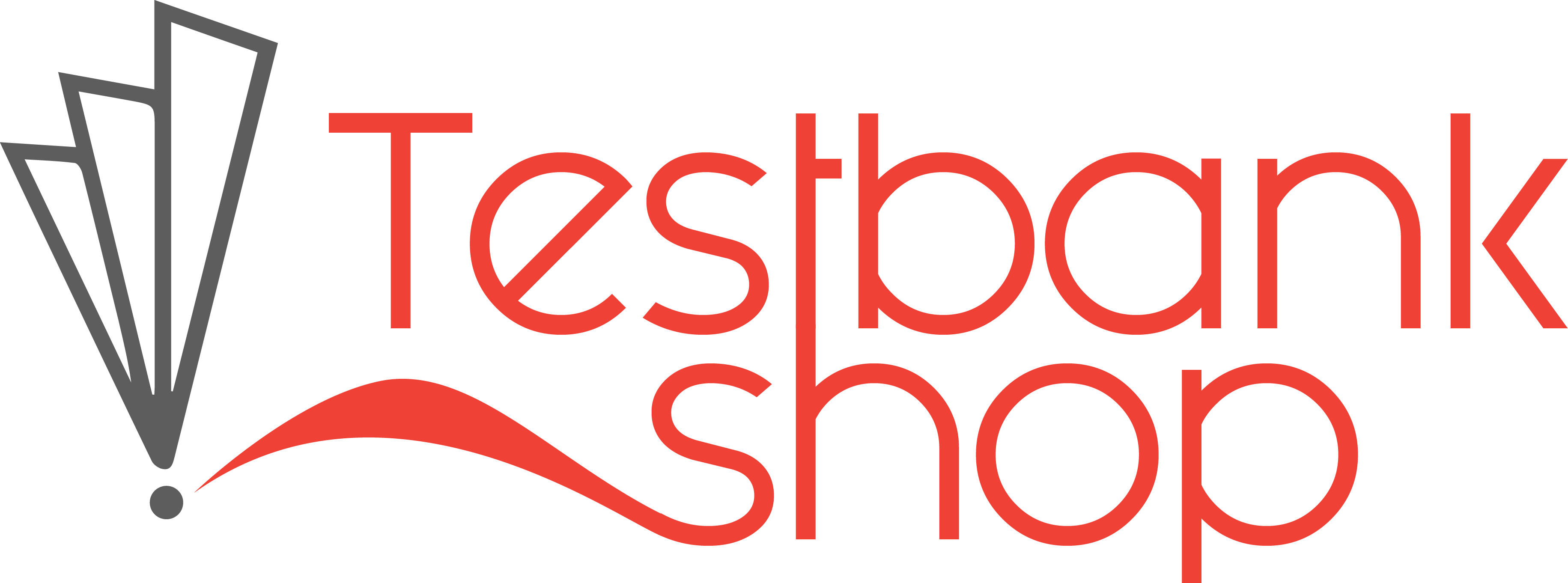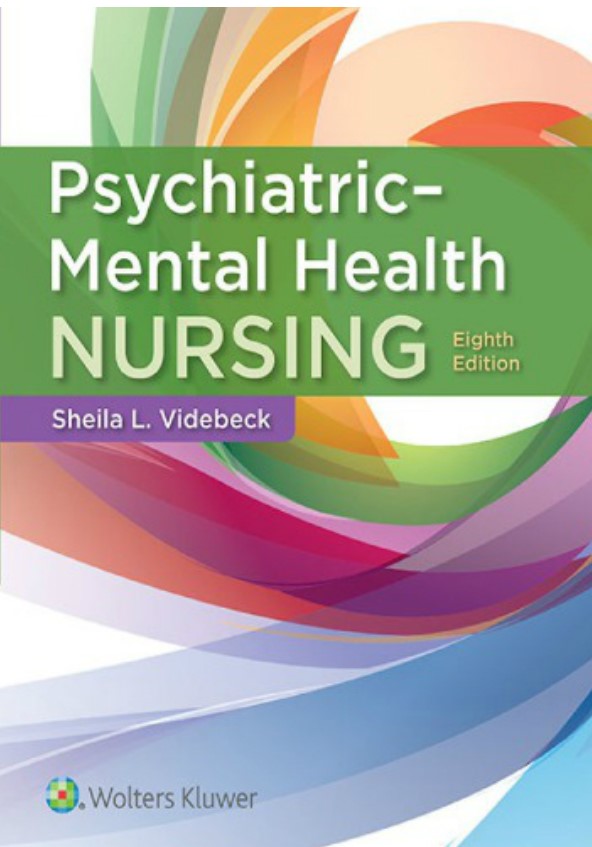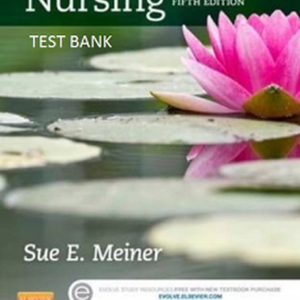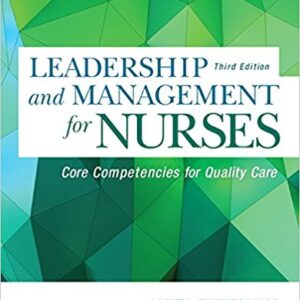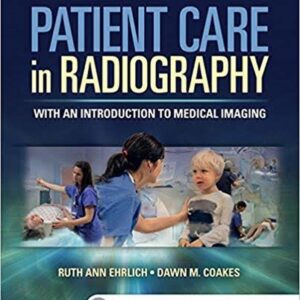Test Bank for Psychiatric Mental Health Nursing 8th Edition By Wanda Mohr
Chapter 01- Introduction to Psychiatric-Mental Health Nursing
- A nurse is giving a presentation about preventing mental illness to college freshmen. A student asks, “What does it mean to be mentally healthy?” Which of the following potential responses by the nurse is best?
A) “Mental health is difficult to define and depends on cultural norms.”
B) “Mental health is marked by productivity, fulfilling relationships, and adaptability.”
C) “Mental health is characterized by the absence of mental illness.”
D) “Mental health is the performance of behavior that is accepted as normal.”
- A 48-year-old independent, successful woman is recovering from a modified radical mastectomy. She states she was grateful that during the first few weeks after surgery her mother stayed with her and did “everything” for her. Which element of mental health does this reflect?
A) Reality orientation
B) Mastery of the environment
C) Self-governance
D) Tolerance of the unknown
- Why is the document Mental Health: A Report of the Surgeon General (1999) most significant?
A) Because it states clearly that there are effective treatments for mental illness
B) Because it allocates research money to psychiatric facilities
C) Because it sets new guidelines for use of restraints
D) Because it establishes reimbursement guidelines for third-party payers
- While a nurse is performing an admission assessment for a mental health client, the client states that all of his problems have been caused by his parents. The nurse knows that psychological factors that can influence mental health include which of the following?
A) Neuroanatomy
B) Emotional developmental level
C) Values and beliefs
D) Religion
- What is the primary purpose of the five-axis system used in the fourth edition of the Diagnostic and Statistical Manual of Mental Disorders, 4th edition, text revision(DSM-IV-TR)?
A) To separate the various mental disorders into five related categories
B) To give a comprehensive picture of client functioning
C) To improve prognostic ability
D) To provide a decision-making algorithm for pharmacologic treatment
- One limitation of the DSM relates to diagnostic labels given to children. The most problematic issue caused by applying adult categories to children is which of the following?
A) It prevents the proper treatment of childhood disorders.
B) The criteria for diagnosis of a disorder are flexible for an adult, but not for children.
C) Categories are based on manifestations of adult disorders, not research in children.
D) The DSM was written before childhood psychological conditions were recognized.
- Which of the following represents a problem complicating the treatment of people with mental illness?
A) Insurers’ reimbursement decisions
B) Increased responsibility for care by state mental hospitals
C) Overuse of the well-coordinated mental health care system
D) Lack of effective treatments
- Julie, a 47-year-old woman, missed 1 week of work when she was hospitalized with bipolar disorder. She was placed on medication and was able to return to work. When asked about her absence, Julie informed coworkers that she was suffering from influenza. What is the most likely reason Julie lied about her illness?
A) This is a sign that the medication is not effectively treating her illness.
B) Fear of rejection, isolation, and discrimination based on her mental health diagnosis
C) Due to workplace policies that encourage the firing of those with mental illnesses
D) To avoid eliciting sympathy among her coworkers
- A 22-year-old man with a history of a recent suicide attempt is being treated for depression. Prior to becoming depressed, the client attended a prestigious art school and enjoyed many social and leisure activities. Of the following long-term goals for this client, which is consistent with an overarching recovery goal for all clients with mental disorders?
A) The client will not injure himself.
B) The client’s symptoms will be reduced.
C) The client will show interest in social and leisure activities.
D) The client will resume pre-illness functioning.
- Which of the following approaches to care best reflects cultural competence?
A) Always assign nurses of a specific ethnic background to clients with the same ethnic background.
B) Learn the behaviors and values associated with people of specific ethnic backgrounds.
C) Assess the culturally mediated beliefs of each client.
D) Believe that people are more alike than they are different.
Chapter 02- Neuroscience-Biology and Behavior
- The basic units of structure and function in the nervous system are called which of the following?
A) Glial cells
B) Neurons
C) Axons
D) Dendrites
- The structure and function of a neuron form the basis for the overall function of the nervous system. What are the components of a neuron?
A) A glial cell, nucleus, organelles, dendrites, and axons
B) A glial cell, nucleus, dendrites, and synapses
C) A cell body, nucleus, organelles, dendrites, and axons
D) A cell body, nucleus, axon, and synapses
- A patient has researched the role of neurotransmitters in her mental illness. What is the role of neurotransmitters?
A) Excite the receptor cell located inside the synaptic cleft.
B) Inhibit the receptor cell found inside of glial cells.
C) Communicate information within the receptor cell.
D) Communicate information from one cell or cell group to another.
- Because neurotransmitters are responsible for immediately transmitting impulses between nerve cells, they are known as which of the following?
A) First messengers
B) Second messengers
C) Receptors
D) Synapses
- A nurse is caring for a patient who is addicted to alcohol and drugs and is discussing the pathway of the brain responsible for this behavior. The nurse should know that the pathway of the brain thought to be involved in pleasurable sensations and the euphoria resulting from use of drugs is called the:
A) Tuberinfundibular dopamine pathway
B) Nigrostriatal dopamine pathway
C) Mesocortical dopamine pathway
D) Mesolimbic dopamine pathway
- A client lives with acquired deficits in emotional control, memory, and learning. What part of this client’s brain is most likely affected?
A) Basal ganglia
B) Brainstem
C) Limbic system
D) Cerebellum
- You are caring for a mental health client who has developed difficulty with balance and muscle tone after a car accident that involved a head injury. Based on this information, what area of the brain was most likely injured in the accident?
A) Diencephalon
B) Brainstem
C) Cerebellum
D) Pons
- A client who experiences dysfunction in the hypothalamus is most likely to have
A) Maintaining homeostasis
B) Processing sensory input
C) Secreting melatonin
D) Integrating motor activities
- Sensory deprivation in infancy and childhood has adversely affected a boy’s brain development. Which characteristic of the brain was most directly involved in this process?
A) Neuroplasticity
B) Reactive plasticity
C) Adaptive plasticity
D) Synaptic plasticity
- Rather than being 100%, concordance rates for schizophrenia in monozygotic twins are only 50%. Which of the following statements best explains this phenomenon?
A) Genetic predisposition to disease is frequently overstated.
B) One twin is inherently more vulnerable in every case.
C) Environmental experiences affect gene expression.
D) The genetic pathway responsible for vulnerability is unrelated to being a twin.
Chapter 03- Conceptual Frameworks and Theories
- A psychiatric–mental health nurse is aware of the importance of theories in the development and delivery of care. Which of the following is the best definition of a theory?
A) A group of related concepts or ideas
B) A person’s or group’s beliefs about how something happens or works
C) A prediction about two or more concepts
D) A researchable question related to health care
- Which of the following explains why theories are important to psychiatric–mental health nursing?
A) Theories provide more treatment options for clients.
B) Theories add professionalism to health care.
C) Theories simplify treatment decisions for most clients.
D) Theories lead to the expansion of knowledge.
- A client has been told by a psychologist that memories in his unconscious are contributing to his depression. This reasoning implies that the psychologist ascribes to what theory?
A) Psychoanalytic theory
B) Behavior theory
C) Cognitive–behavioral theory
D) The humanistic perspective
- A client’s current plan of care includes interventions that are rooted in the concepts of reinforcement. Which theory of human behavior is being prioritized during this client’s care?
A) Humanistic theory
B) Sociocultural theory
C) Behavioral theory
D) Psychoanalytic theory
- A client and her therapist have been discussing the notion that her psychopathology results from the blocking or distortion of personal growth, excessive stress, and unfavorable social conditions. This discussion is congruent with what theory?
A) Humanistic theory
B) Interpersonal theory
C) Biophysiological theory
D) Sociocultural theory
- During marital counseling, a man complains that his wife often “bombards” him with problems as soon as he settles down at home after work, which results in a prolonged argument. The wife admits that she does this but states she feels neglected and that her husband does not take the family problems seriously. She doesn’t want her marriage to turn out like her parents’ marriage. The wife admits that she sometimes provokes an argument in order to gain her husband’s attention. How would a behaviorist most likely explain the wife’s actions?
A) She has repressed painful memories about her emotionally distant father and is working out her anger at the parent in the marital relationship.
B) Her thoughts about her parents’ unhappy marriage are a justification for her behavior.
C) She has an underlying anxiety disorder.
D) The long argument in which she and her husband participate positively reinforces her behavior.
- An adult man recalls that he was teased as a child about his inability to participate in sports. He began to avoid situations in which others might evaluate his behavior. He seeks treatment now because he is an accomplished musician but cannot perform for an audience. According to behavioral theory, his behavior is an example of which of the following concepts?
A) Discrimination
B) Modeling
C) Generalization
D) Shaping
- The nurse is working with a client who admits to having low self-esteem. The care team has determined that cognitive restructuring will likely enhance the client’s self-esteem. Which of the following best describes the goals of this intervention?
A) Avoid negative self-talk
B) Replace negative self-talk with positive statements
C) Change distorted thinking and the subsequent behaviors
D) Use adaptive defense mechanisms
- A 55-year-old woman is being treated for narcissistic personality disorder. The therapist demonstrates caring and appropriate regard for the client. The therapist’s behavior is an example of which concept of behavior theory?
A) Shaping
B) Discrimination
C) Modeling
D) Conditioning
- In a group therapy session, group members confront a 35-year-old woman about her abuse of prescription pain medications. The woman states that, because a physician has prescribed her medication, she is not a drug addict. The nurse identifies this as an example of which of the following defense mechanisms?
A) Regression
B) Projection
C) Denial
D) Sublimation
Chapter 04- Evidence-Based Practice
- The nurse demonstrates a commitment to the health, safety, and welfare of people by providing evidence-based practice. What does the term “evidence-based practice” mean?
A) Care that integrates research and clinical expertise with the client’s characteristics, culture, and preferences
B) Care that bases decision making on established clinical protocols
C) Care based on prior outcomes from the nurse’s practice
D) Care based on outcomes and research conducted by the practitioner
- Many pseudoscientific practitioners function openly and market themselves as mainstream
“therapists.” Why does the public often respond favorably to unconventional therapies?
A) Pseudoscientific therapies are frequently more effective than conventional therapies.
B) Further advancements can be made in effective pseudoscientific treatments with continued practice.
C) Malpractice is minimized because pseudoscientific treatments are not empirically supported.
D) Some clients and families are disenchanted with the outcomes of professionally approved treatments.
- Nursing is both an art and a science. Which statement best represents how evidence-based practice encompasses these two aspects of nursing?
A) The art of nursing has been replaced by evidence-based practice.
B) Multiple theoretical perspectives no longer guide evidence-based nursing care.
C) The art of nursing is demonstrated through carrying out the science of nursing in a skillful, knowledgeable, intelligent, and ethical manner.
D) The artful side of nursing is of less value to positive patient outcomes than is the science of nursing.
- Evidence-based practice is based on the scientific method and empirical evidence. Which of the following is a principle of empirical evidence?
A) Scientific observations are subjective inferences made by the knowledgeable nurse researcher.
B) Empirical studies may be designed to report the physical and mental effects of subjective experiences.
C) Empirical evidence is not appropriate in the field of mental health because cognitions and emotions are subjective and unpredictable.
D) Empirical knowledge is verifiable only with valid and reliable measurement instruments.
- The nurse is part of team conducting a research study that involves controlled observations. Controlled observations involve which of the following activities?
A) Putting information together to form a new understanding
B) Watching something carefully and noting events
C) Testing a hypothesis or prediction
D) Determining whether data are reliable and supportive
- Two patients with schizophrenia have consented to be involved in clinical trials to determine the efficacy of a new antipsychotic medication. The researcher administers the new drug to one subject and a sugar pill to another subject. The patient who received the sugar pill received a treatment that is considered which of the following?
A) Sham treatment
B) Unethical treatment
C) Placebo
D) Supplemental therapy
- A research team has been formed to study a new medication and its effects on depression. The researcher wants to use a design where neither the clients nor the research staff will know who is receiving the medication or the placebo. What type of study is this group conducting?
A) An empirical study
B) An evidence-based study
C) A case-control study
D) A double-blind study
- A researcher is determining whether data that were obtained in a psychiatric nursing study are reliable and whether the data support the study hypothesis. In what part of the scientific process is the researcher functioning?
A) Experimentation
B) Analysis
C) Synthesis
D) Prediction
- The nurse is working with a 42-year-old female patient who is mildly overweight. The patient expresses a desire to “tone up” before summer and is interested in trying an over-the-counter weight loss remedy. The nurse should perform health education related to what subject?
A) To be wary of any product that claims rapid or effortless results without exercise
B) The relatively low risk of using natural remedies
C) The small amount of active ingredient in most over-the-counter treatments
D) To choose a product that reports data indicating a high degree of effectiveness
- Many people get health care information from the Internet. Hence, evidence-based health care can be threatened by the proliferation of pseudoscientific information available to the public. Which measure is currently being taken to prevent the misinformation of the healthcare consumer?
A) Evidence-based knowledge is currently only disseminated in professional journals and publications.
B) The Food and Drug Administration (FDA) has been denied the jurisdiction to prosecute unscrupulous internet marketers.
C) Public education is being performed by the Federal Trade Commission (FTC) through a campaign called Operation Cure All.
D) Websites publicizing misinformation on the Internet are being screened and blocked.
Chapter 05- Legal and Ethical Aspects
- A psychiatric–mental health nurse has been consistently aware of the need to adhere to standards of practice during interactions with clients and their families. What is a standard of nursing practice?
A) The body of text in the state nurse practice act
B) A document outlining minimum expectations for safe nursing practice
C) Unwritten but traditional practices that constitute safe nursing care
D) Part of the federal nurse practice act
- Nursing students are reviewing the nurse practice act in the state where they reside. A state’s nurse practice act has which of the following functions?
A) Makes recommendations for how nurses should practice
B) Defines the scope and limit of nursing practice
C) Defines specific situations that constitute malpractice
D) Follows federal laws about nursing practice
